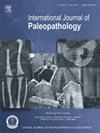Bone trauma and interpersonal care among Late Holocene hunter-gatherers from Patagonia, Argentina
IF 1.5
3区 地球科学
Q3 PALEONTOLOGY
引用次数: 0
Abstract
Objective
To evaluate the social implications of traumatic injuries in non-sedentary hunter-gatherers by analysing osteological remains through models based on the Bioarchaeology of Care.
Materials
Human skeletal remains from North Patagonia (Late Holocene). 3179 anatomical elements from 189 individuals of both sexes and different age categories.
Methods
Macroscopic analysis of all bones to identify two injury types (dislocations and fractures) to apply the Index of Care to each case.
Results
About 20 % of individuals suffered injuries, mostly mild, requiring short-term care. Severe cases needed intensive care, likely disrupting the normal routines of daily life in the group.
Conclusions
Despite logistical costs and disabilities that led, in some cases, to social reorganisation of daily or planned activities, these groups ensured their peers' survival and recovery through care.
Significance
The Index of Care was expanded by defining categories based on care intensity, applicable to any context, and offers new information about interpersonal care in Patagonia.
Limitations
Only osteological remains are available to assess interpersonal care.
Suggestions for further research
Incorporate other pathological conditions (e.g., bone infections) and more samples on a larger spatial-temporal scale to evaluate interpersonal care in the region.
阿根廷巴塔哥尼亚晚全新世狩猎采集者的骨创伤与人际关怀
目的通过基于护理生物考古学的模型分析骨骼遗骸,评估创伤性损伤对非久坐狩猎采集者的社会影响。北巴塔哥尼亚的人类骨骼残骸(晚全新世)。来自189个不同性别和年龄类别的个体的3179个解剖元素。方法对所有骨进行显微分析,确定两种损伤类型(脱位和骨折),并应用护理指数(Index of Care)。结果约20% %的患者出现损伤,多数为轻度损伤,需要短期护理。严重者需要重症监护,可能会扰乱该群体的正常日常生活。尽管在某些情况下,后勤成本和残疾导致了日常或计划活动的社会重组,但这些小组通过护理确保了同龄人的生存和康复。通过定义基于护理强度的类别来扩展护理指数,适用于任何情况,并提供有关巴塔哥尼亚人际护理的新信息。局限性:只有骨骼遗骸可用于评估人际护理。进一步研究的建议:在更大的时空尺度上,结合其他病理条件(如骨感染)和更多的样本来评估该地区的人际护理。
本文章由计算机程序翻译,如有差异,请以英文原文为准。
求助全文
约1分钟内获得全文
求助全文
来源期刊

International Journal of Paleopathology
PALEONTOLOGY-PATHOLOGY
CiteScore
2.90
自引率
25.00%
发文量
43
期刊介绍:
Paleopathology is the study and application of methods and techniques for investigating diseases and related conditions from skeletal and soft tissue remains. The International Journal of Paleopathology (IJPP) will publish original and significant articles on human and animal (including hominids) disease, based upon the study of physical remains, including osseous, dental, and preserved soft tissues at a range of methodological levels, from direct observation to molecular, chemical, histological and radiographic analysis. Discussion of ways in which these methods can be applied to the reconstruction of health, disease and life histories in the past is central to the discipline, so the journal would also encourage papers covering interpretive and theoretical issues, and those that place the study of disease at the centre of a bioarchaeological or biocultural approach. Papers dealing with historical evidence relating to disease in the past (rather than history of medicine) will also be published. The journal will also accept significant studies that applied previously developed techniques to new materials, setting the research in the context of current debates on past human and animal health.
 求助内容:
求助内容: 应助结果提醒方式:
应助结果提醒方式:


